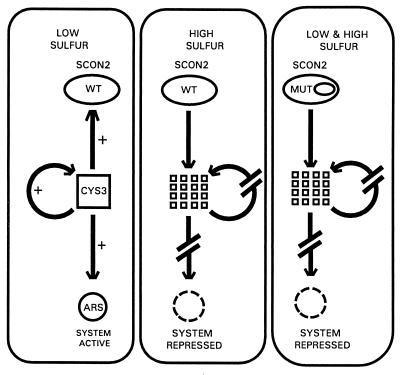Figure 4.
Diagrammatic model of SCON2 function within the N. crassa sulfur regulatory network. To emphasize the different functional states exhibited by SCON2, this model has been partitioned according to sulfur status as well as the mutational state of scon-2+. Under low sulfur conditions, wild-type scon-2+ does not effect repression of the transcriptional activator cys-3+, allowing CYS3-mediated activation of itself, scon-2+, and the entire set of sulfur-regulated structural genes (represented by arylsulfatase). Under high sulfur conditions, however, wild-type scon-2+ functions to repress cys-3+, possibly through a pathway ultimately resulting in CYS3 proteolysis. CYS3 destruction would eliminate the activation pathways mentioned previously, thereby resulting in sulfur-system repression. (Right) Site-directed mutagenesis of conserved residues within the SCON2 F-box results in cys-3+ repression (again, possibly through CYS3 proteolysis) under both low and high sulfur conditions. The SCON2 F-box, therefore, stands as a key regulatory target mediating the functional state of SCON2 within the N. crassa sulfur control system.

